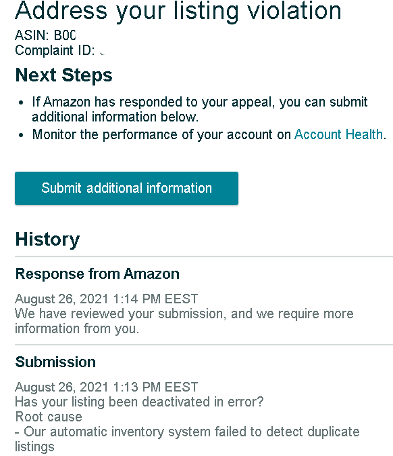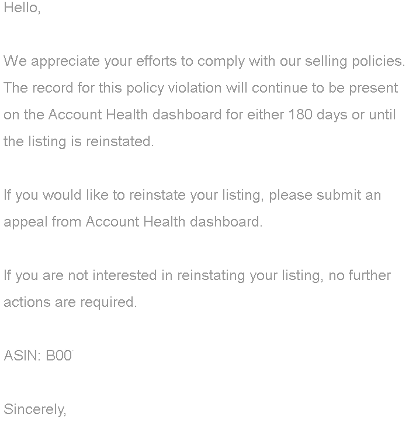
If you want to reinstate your listings, you need to write a good Amazon appeal letter. There’s no way around it. But a new situation arises: the automated Amazon suspension appeal response. Find out if your Amazon appeal stands a chance.
Amazon suspensions are a thorny issue. They’re not all dealt with in the same way, they can be very confusing, and there’s no room for error.
To make matters worse, Amazon doesn’t exactly go easy on sellers once their accounts are suspended.
We know this topic deserves a lot of attention, so we’re dedicating an entire series to it. But it’s not all about appeal letters, POAs, and Amazon suspension appeal responses.
Let’s also look at the recent auto-reply appeal response and all the head-scratching that comes with it.
Types of Amazon Suspensions
There are several types of suspensions on Amazon, as explained in our How to Sell on Amazon series.
Some require a reply by a given deadline. You may have as little as 3 days to send an Amazon appeal letter in response, though it’s usually more.
Either way, you should put all your effort into writing your Amazon appeal letter on time.
As always, every word counts. And less is more.
But the way you draft your Amazon appeal letter has changed.
These days, you’ll probably need to fill in a form through your dashboard.
You may be asked for a Plan of Action (POA)This is a written account of how you int… More, but the format will vary.
Amazon might expect all 3 of the standard sections: root cause, corrective action, preventive measures.
Or it might ask you to tick some boxes instead, confirming you understood the policy, removed an ASIN, etc.
Your odds of reinstatement and the work you put into your appeal will depend on the type of Amazon suspension.
Some are straightforward, but others are near impossible to sort out.
We’ve grouped them into 10 categories, each with different options.
Here they are:
1.Inauthentic / Counterfeit Items. Amazon’s bots can pick up words in buyer messages, feedbackA performance rating on a scale of 1 to … More, listing descriptions or keywords.
If they flag something up, you can have your selling privileges revoked.
This is in line with anti-counterfeiting policy.
If you don’t suspect foul play from a competitor, you should check the dashboard and provide Amazon proof of authenticity. Itemized invoices will usually suffice.
There’s no need to send an Amazon appeal letter, though you might want to give your inventory a once-over.
2.Safety Infringing or Expired Items.
These suspensions are common with FBA products.
They must adhere to very strict rules in terms of storing, prepping, and labelling. Amazon may expect you to dispose of the items, change storage conditions, add warning labels, provide setup instructions, and keep (M)SDSs.
You’ll be asked to submit an Amazon appeal letter. And you won’t be able to submit it unless you have all the documents Amazon asks for.
These claims also fall into the safety category and link up to counterfeit claims, so you risk losing your selling privileges over them.
After checking Condition Guidelines and improving the way you store and handle items (e.g. polybagging or shrink wrapping), you might need to show Amazon proof that you’ve changed packing procedures or set up a quality control department.
In extreme cases, if your supplier is on Amazon’s or another international supplier blacklist, you might be expected to break up that collaboration.
4.Not as Advertised or Wrong Item.
These days, a ‘Wrong Item’ claim isn’t so much a safety concern as it is a matter of customer dissatisfaction.
These suspensions tend to be triggered by something flagged up in the Voice of the Customer dashboard.
They can happen because of an issue with the conditionProducts can only be listed on Amazon if… More of the item, the labeling, incomplete descriptions, or duplicate listings. It’s a very common problem with sellers who drop-ship or use feeds to streamline purchases from suppliers.
Tackling this issue could be as simple as having a fail-safe in place. It may be an extra pair of eyes in packaging, an automated alert, or a blacklisting system. Or it might involve changing suppliers or even adjusting your business model.
5.Negative FeedbackA performance rating on a scale of 1 to … More/ Late Shipment Rate/ Performance Issues.
There are 10 performance metrics that affect your selling privileges.
And there’s an unspoken rule that they should be checked daily.
There’s a lot you can do to persuade Amazon to reinstate your account, but not before you read our free How to Sell on Amazon ebook for the latest tips.
6.Selling Restricted Selling certain product categorie… More Items.
Amazon restricts and often bans the sale of some items. There are countless brands and categories that are restricted or ‘gated’.
And as our ungatingPlease see “Gated” experts will readily reveal, it can take weeks and up to $5,000 to ‘ungate’ a single one.
Luckily, our scouting app Profit Bandit can warn you that an item is restricted, even before you’ve listed it.
These are listings that make prohibited claims.
They often have something to do with lapsed certification, incomplete lists of ingredients, and statements about diseases or approvals (e.g. FDA-approved).
A good Amazon appeal letter should show that you’ve taken steps to rid your listings, inventory, and suppliers of the products or these claims for good.
8.Duplicate Accounts / Opening a Second Account after Suspension.
If Amazon allowed you to have two accounts in the past, you have a shot at convincing them to reinstate your selling privileges.
And if your new account is used for entirely different products with totally different suppliers and logistics, you may be able to wiggle out of this one.
Otherwise, the odds are stacked against you. But you could enlist the help of an account reinstatement expert, as a last resort.
9.Rights Owner Notice Complaint/ Intellectual Property Complaints.
Amazon will only remove complaints if the rights owner retracts them, you come up with an acceptable invoice or authorization letter, or the claims are more than 6 months old.
The modus operandi in this case is to contact the rights owner and come to an agreement.
You may need to pester the Notice Dispute team for their contact details, as explained here.
But if the claimant is blatantly lying, a counter-notice might be in order. If you phrase the counter-notice right, Amazon will reinstate your listing when the matter is settled with the alleged rights owner.
10.Selling Violations (e.g. Fair Price, Duplicate Listings).
There are many ways to get suspended for pricing gouging, ‘gaming the system’, or even for having your listings hijacked and duplicated by a competitor.
To reinstate a hijacked listing, you may need to get in touch with a Catalog Team member to report a competitor for sabotage, and then take the matter up with Seller Support.
But if it’s because of a pricing issue, you must appeal to Amazon and prove that you’ve improved your pricing methodology.
It might help to switch to a clever repricer like Sellery that can adhere to Amazon’s price rules, ignore or blacklist certain competitors, and abide by your repricing rules and schedules.
So, that’s how you’d normally set about dealing with specific types of suspensions.
But there’s a new scenario now linked to some types of suspension cases. It’s Amazon’s auto-reply. We brought it up in the latest edition of the Amazon Seller Digest. And we’re sorry to say the problem still exists on some venues.
What Is Happening to Amazon Appeals?
So, what’s all this about?
Sellers report that they’ve been receiving instant responses to their Plans of Action (POAs). Sometimes they’re conflicting replies. And it’s been happening since July. Nobody seems to be reading some of these POAs or inspecting the attached files anymore.
Responses are displayed in the Account HealthAccount Health is an Amazon page which c… More dashboard.
They often come with the same timestamp as the appeals.
So, Amazon appeals are now being dealt with automatically. A bot is probably skimming through the data and rejecting IP appeals without so much as a glance.

For IP infringement complaints, these rejections now come as standard.
But they’ve also crossed over to other suspensions. For instance, duplicate listings are treated the same. As seen below, the appeal is denied on the spot. And there’s the same vague request for extra information.

To make matters worse, Performance NotificationsWarning messages sent by Amazon’s Sell… More are confusing.
You get the same message for any suspension, save for the ASIN at the end. And they urge you to submit an appeal from the Account HealthAccount Health is an Amazon page which c… More dashboard, where you’ve already submitted all you could and should.

In the olden days, Amazon’s Notice Dispute Department, Performance Team, or Seller Support team would have provided their contact details and a list of all the extra documents they require, as shown here. But they’re keeping everyone in the dark for the moment.
So, sellers are caught in a vicious cycle. They submit appeals from the dashboard, which asks for extra information. They try to find out what “additional information” means. They check Performance NotificationsWarning messages sent by Amazon’s Sell… More. They’re sent back to the dashboard for an endless back and forth.
What Does the Amazon Suspension Appeal Auto-Response Mean?
It seems these auto-rejections aren’t new.
According to reports on the seller forums, they were taking place as early as Aug. 2020.
And since they’re already being widely used for IP infringement and Duplicate appeals, this practice might carry on till the end of the year.
But why would Amazon use bots to skim through POAs?
Our best guess is that Amazon is running some tests and exploring ways to optimize this process.
It may be trying to boost efficiency or sift out bad sellers for Q4.
Or it may be trying to trim its workforce with bots. Based on the Amazon Flex issues reported by Bloomberg and Ars Technica, that last option doesn’t bode well for sellers.
But seeing as the latest VP for Selling Partner Services has worked in software development all his life, none of this should come as a surprise.
Hopefully, Amazon will soon understand the importance of letting real live people handle suspension appeals.
Speaking of which, there is good news!
As of this week, Amazon’s standard response, promising a reply within 2-3 days, is back on US accounts. We are hopeful this will apply to all US sellers, and Amazon will extend this gesture of goodwill to the rest of the venues as well.
What Options Do Amazon Sellers Have?
Amazon is going all in on automation, so it’s safe to assume that these auto-responses are the first of many tests.
If you’re ever hit with one of these automated Amazon suspension appeal responses, and you’re at a loss to know why or what you can do about it, here are your options:
Escalate
Forget emailing Jeff Bezos.
If you’re enrolled at Brand RegistryAmazon Brand Registry is a tool that ena… More, you already have a go-to person for Amazon’s glitches.
If not, you need to take it up with Seller Support.
Request a call back through Seller CentralAmazon Seller Central is a portal or a h… More. Then ask to speak to a senior investigator or Seller PerformanceA measure of how well Amazon sellers are… More manager.
If possible, ask to be transferred to a member of the Captive Team
And if you don’t have much luck there either, ask for the Executive Seller Relations (a.k.a. Escalations) Team. But before you do any of this, make sure your POA is up to par.
Get in touch with an Amazon Reinstatement Service Provider
Our Listing Reinstatement team has the solutions as well as the human touch.
We can review your case, provide a free assessment, and set the wheels in motion so that you recover your listing, restore your metrics, and resume trading.
We don’t do templates and we intervene as many times as needed. And if you need an extra push, our Amazon Coaching team is here to point you in the right direction.
Now that Part 1 of the Amazon Suspension series is coming to an end, we’re happy to report that we’ll be coming out with a new installment every month. Each one will address a current issue or bring to light a new scenario for sellers struggling to deal with the dreaded Amazon appeal.

Melanie takes an active interest in all things Amazon. She keeps an eye on the latest developments and keeps Amazon sellers up to speed.




